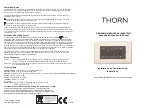
Configuration Files Larger than NVRAM
To maintain a configuration file that exceeds the size of NVRAM, you should be aware of the information in
the following sections.
Compressing the Configuration File
The
service compress-config
global configuration command specifies that the configuration file be stored
compressed in NVRAM. Once the configuration file has been compressed, the device functions normally.
When the system is booted, it recognizes that the configuration file is compressed, expands it, and proceeds
normally. The
more nvram:startup-config
EXEC command expands the configuration before displaying
it.
Before you compress configuration files, refer to the appropriate hardware installation and maintenance
publication. Verify that your system’s ROMs support file compression. If not, you can install new ROMs that
support file compression.
The size of the configuration must not exceed three times the NVRAM size. For a 128-KB size NVRAM, the
largest expanded configuration file size is 384 KB.
The
service compress-config
global configuration command works only if you have Cisco IOS software
Release 10.0 or later release boot ROMs. Installing new ROMs is a one-time operation and is necessary only
if you do not already have Cisco IOS Release 10.0 in ROM. If the boot ROMs do not recognize a compressed
configuration, the following message is displayed:
Boot ROMs do not support NVRAM compression Config NOT written to NVRAM
Storing the Configuration in Flash Memory on Class A Flash File Systems
On class A Flash file system devicees, you can store the startup configuration in flash memory by setting the
CONFIG_FILE
environment variable to a file in internal flash memory or flash memory in a PCMCIA slot.
See the
Specifying the CONFIG_FILE Environment Variable on Class A Flash File Systems , on page 174
section for more information.
Care must be taken when editing or changing a large configuration. Flash memory space is used every time
a
copy system:running-config nvram:startup-config
EXEC command is issued. Because file management
for flash memory (such as optimizing free space) is not done automatically, you must pay close attention to
available flash memory. Use the
squeeze
command to reclaim used space. We recommend that you use a
large-capacity Flash card of at least 20 MB.
Loading the Configuration Commands from the Network
You can also store large configurations on FTP, RCP, or TFTP servers and download them at system startup.
To use a network server to store large configurations, see the
Copying a Configuration File from the Device
to a TFTP Server , on page 153
and
Configuring the Device to Download Configuration Files, on page 149
sections for more information on these commands.
Configuring the Device to Download Configuration Files
You can configure the device to load one or two configuration files at system startup. The configuration files
are loaded into memory and read in as if you were typing the commands at the command line. Thus, the
configuration for the device is a mixture of the original startup configuration and the one or two downloaded
configuration files.
System Management Configuration Guide, Cisco IOS XE Gibraltar 16.10.x (Catalyst 9200 Switches)
149
Managing Configuration Files
Configuration Files Larger than NVRAM
















































